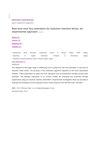金比例矩形谐振腔金属-石墨烯混合等离子体纳米天线检测2,4-二硝基甲苯
IF 0.9
4区 工程技术
Q4 ENGINEERING, ELECTRICAL & ELECTRONIC
引用次数: 0
摘要
等离子体纳米天线阵列在检测化学分子、生物分子、病毒和病原体方面越来越受欢迎。在这项研究中,我们的目标是用金属-石墨烯杂化等离子体矩形纳米天线检测爆炸性2,4-二硝基甲苯(2,4-DNT),该天线通过从斐波那契级数中选择两个连续的数字形成黄金比例大小。金色矩形谐振器提供了近乎完美的吸收,而无需阻抗匹配计算和复杂的优化算法。在表面增强红外吸收(SEIRA)应用中,金属纳米结构的内部损耗会降低其传感性能。为了提高性能灵敏度,使用了具有高电导率和电可调谐性的石墨烯。金属-石墨烯杂化结构增强了2,4-DNT在6300nm、6580nm和7500nm处的光谱指纹。通过将石墨烯和纳米天线以黄金比例结合起来,并通过调整石墨烯的费米能级,引入的生物传感器平台有利于高灵敏度的可调谐生物传感器,用于宽光谱识别特定生物分子的分子指纹。本文章由计算机程序翻译,如有差异,请以英文原文为准。
Detection of 2,4-Dinitrotoluene by Metal-Graphene Hybrid Plasmonic Nanoantennas with a Golden Ratio Rectangular Resonator
Plasmonic nanoantenna arrays have become increasingly popular for the detection of chemical molecules, biomolecules, viruses, and agents. In this study, our objective was to detect explosive-based 2,4-dinitrotoluene (2,4-DNT) with a metal-graphene hybrid plasmonic rectangular nanoantenna with a golden ratio size formed by choosing two consecutive numbers from the Fibonacci series. The golden rectangular resonator provides nearly perfect absorption without the need for impedance matching calculations and complex optimisation algorithms. In surface enhanced infrared absorption (SEIRA) applications, the internal losses of metallic nanostructures degrade their sensing performance. To improve performance sensitivity, graphene with high electrical conductivity and electrical tunability was used. The spectral fingerprints of 2,4 DNT at 6300 nm, 6580 nm, and 7500 nm were enhanced with a metal-graphene hybrid structure. The biosensor platform introduced, by combining the graphene and nanoantennas with a golden ratio and by adjusting the Fermi energy level of graphene, can be beneficial for highly sensitive tunable biosensors for a broad spectrum to identify the molecular fingerprints of specific biomolecules.
求助全文
通过发布文献求助,成功后即可免费获取论文全文。
去求助
来源期刊

Elektronika Ir Elektrotechnika
工程技术-工程:电子与电气
CiteScore
2.40
自引率
7.70%
发文量
44
审稿时长
24 months
期刊介绍:
The journal aims to attract original research papers on featuring practical developments in the field of electronics and electrical engineering. The journal seeks to publish research progress in the field of electronics and electrical engineering with an emphasis on the applied rather than the theoretical in as much detail as possible.
The journal publishes regular papers dealing with the following areas, but not limited to:
Electronics;
Electronic Measurements;
Signal Technology;
Microelectronics;
High Frequency Technology, Microwaves.
Electrical Engineering;
Renewable Energy;
Automation, Robotics;
Telecommunications Engineering.
 求助内容:
求助内容: 应助结果提醒方式:
应助结果提醒方式:


